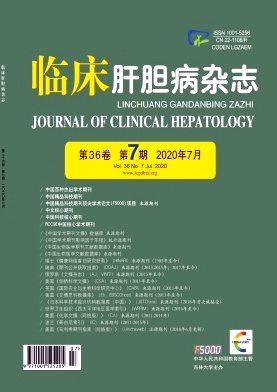|
[1]LU FM,ZHUANG H.Management of hepatitis B in China[J].Chin Med J(Engl),2009,122(1):3-4.
|
|
[2]WANG FS,FAN JG,ZHANG Z,et al.The global burden of liver disease:The major impact of China[J].Hepatology,2014,60(6):2099-2108.
|
|
[3]HENDRIKX T,SCHNABL B.Antimicrobial proteins:Intestinal guards to protect against liver disease[J].J Gastroenterol,2019,54(3):209-217.
|
|
[4]SENDER R,FUCHS S,MILO R.Revised estimates for the number of human and bacteria cells in the body[J].PLo S Biol,2016,14(8):e1002533.
|
|
[5]HARTMANN P,CHEN WC,SCHNABL B.The intestinal microbiome and the leaky gut as therapeutic targets in alcoholic liver disease[J].Front Physiol,2012,3:402.
|
|
[6]LIN R,ZHOU L,ZHANG J,et al.Abnormal intestinal permeability and microbiota in patients with autoimmune hepatitis[J].Int J Clin Exp Pathol,2015,8(5):5153-5160.
|
|
[7]BHAT M,ARENDT BM,BHAT V,et al.Implication of the intestinal microbiome in complications of cirrhosis[J].World J Hepatol,2016,8(27):1128-1136.
|
|
[8]GINS P,QUINTERO E,ARROYO V,et al.Compensated cirrhosis:Natural history and prognostic factors[J].Hepatology,1987,7(1):122-128.
|
|
[9]D'AMICO G,GARCIA-TSAO G,PAGLIARO L.Natural history and prognostic indicators of survival in cirrhosis:A systematic review of 118studies[J].J Hepatol,2006,44(1):217-231.
|
|
[10]van ERPECUM KJ.Ascites and spontaneous bacterial peritonitis in patients with liver cirrhosis[J].Scand J Gastroenterol Suppl,2006,243:79-84.
|
|
[11]GINS P,CRDENAS A,ARROYO V,et al.Management of cirrhosis and ascites[J].N Engl J Med,2004,350(16):1646-1654.
|
|
[12]BENTEN D,WIEST R.Gut microbiome and intestinal barrier failure-the“Achilles heel”in hepatology?[J].J Hepatol,2012,56(6):1221-1223.
|
|
[13]WIEST R,KRAG A,GERBES A.Spontaneous bacterial peritonitis:Recent guidelines and beyond[J].Gut,2012,61(2):297-310.
|
|
[14]WIEST R,GARCIA-TSAO G.Bacterial translocation(BT)in cirrhosis[J].Hepatology,2005,41(3):422-433.
|
|
[15]NOLAN JP.The role of intestinal endotoxin in liver injury:A long and evolving history[J].Hepatology,2010,52(5):1829-1835.
|
|
[16]GILL SR,POP M,DEBOY RT,et al.Metagenomic analysis of the human distal gut microbiome[J].Science,2006,312(5778):1355-1359.
|
|
[17]CHEN Y,YANG F,LU H,et al.Characterization of fecal microbial communities in patients with liver cirrhosis[J].Hepatology,2011,54(2):562-572.
|
|
[18]SANTIAGO A,POZUELO M,POCA M,et al.Alteration of the serum microbiome composition in cirrhotic patients with ascites[J].Sci Rep,2016,6:25001.
|
|
[19]KANG Y,CAI Y.Gut microbiota and hepatitis-B-virus-induced chronic liver disease:Implications for faecal microbiota transplantation therapy[J].J Hosp Infect,2017,96(4):342-348.
|
|
[20] QIN J,LI R,RAES J,et al.A human gut microbial gene catalogue established by metagenomic sequencing[J].Nature,2010,464(7285):59-65.
|
|
[21]LU H,WU Z,XU W,et al.Intestinal microbiota was assessed in cirrhotic patients with hepatitis B virus infection.Intestinal microbiota of HBV cirrhotic patients[J].Microb Ecol,2011,61(3):693-703.
|
|
[22]TUOMISTO S,PESSI T,COLLIN P,et al.Changes in gut bacterial populations and their translocation into liver and ascites in alcoholic liver cirrhotics[J].BMC Gastroenterol,2014,14:40.
|
|
[23]BAJAJ JS,BETRAPALLY NS,HYLEMON PB,et al.Salivary microbiota reflects changes in gut microbiota in cirrhosis with hepatic encephalopathy[J].Hepatology,2015,62(4):1260-1271.
|
|
[24]QIN N,YANG F,LI A,et al.Alterations of the human gut microbiome in liver cirrhosis[J].Nature,2014,513(7516):59-64.
|
|
[25]WEI X,YAN X,ZOU D,et al.Abnormal fecal microbiota community and functions in patients with hepatitis B liver cirrhosis as revealed by a metagenomic approach[J].BMC Gastroenterol,2013,13:175.
|
|
[26]FAITH JJ,GURUGE JL,CHARBONNEAU M,et al.The longterm stability of the human gut microbiota[J].Science,2013,341(6141):1237439.
|
|
[27]BAJAJ JS,HEUMAN DM,HYLEMON PB,et al.Altered profile of human gut microbiome is associated with cirrhosis and its complications[J].J Hepatol,2014,60(5):940-947.
|
|
[28]BALMER ML,SLACK E,de GOTTARDI A,et al.The liver may act as a firewall mediating mutualism between the host and its gut commensal microbiota[J].Sci Transl Med,2014,6(237):237ra66.
|
|
[29]PONZIANI FR,ZOCCO MA,CERRITO L,et al.Bacterial translocation in patients with liver cirrhosis:Physiology,clinical consequences,and practical implications[J].Expert Rev Gastroenterol Hepatol,2018,12(7):641-656.
|
|
[30]TANG R,WEI Y,LI Y,et al.Gut microbial profile is altered in primary biliary cholangitis and partially restored after UDCA therapy[J].Gut,2018,67(3):534-541.
|
|
[31]YANG R,XU Y,DAI Z,et al.The immunologic role of gut microbiota in patients with chronic HBV infection[J].J Immunol Res,2018,2018:2361963.
|
|
[32]TILG H,CANI PD,MAYER EA.Gut microbiome and liver diseases[J].Gut,2016,65(12):2035-2044.
|







 DownLoad:
DownLoad: